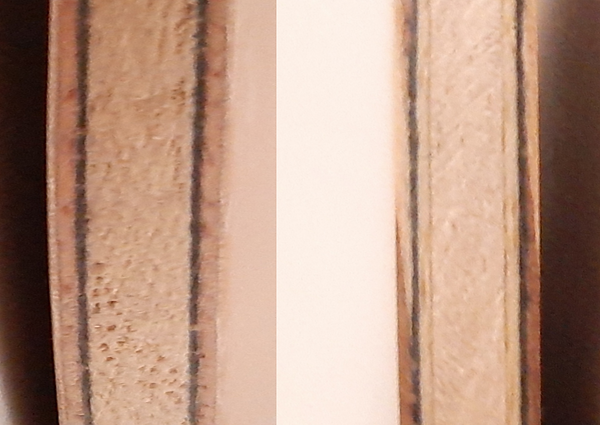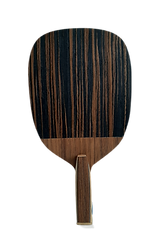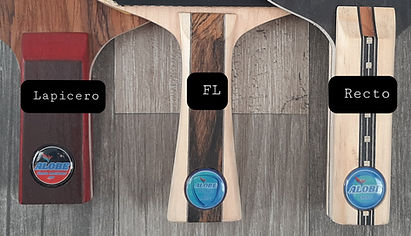
¿ Conoces Tu Madero ?
Lo Primero que hay que tener en consideración, es que todos los jugadores del mundo tienen cualidades distintas, ya sea velocidad, fuerza, reflejos, movimiento, horas de entrenamiento, etc. Son muchos los puntos que influyen incluso la costumbre y conocimiento de los jugadores con su propia equipación.
Es primordial que al momento de eligir tu Equipación sea acorde a tus habilidades, para lo cual debes conocer cuales son tus fortalezas y debilidades.
También es primordial que conozcas tu estilo de juego, te gusta defender, quizás atacar o contraatacar, jugar lo mas cerca de la mesa posible o a media distancia o buscas estar mas atrás por que tu fuerte son los golpes de topspin cargados con mucho efecto.
Al momento de comprar una Madera tienes que pensar en que no eres tu el que se tiene que adaptar al madero, si no lo contrario. El madero que utilices debes adaptarse a tus necesidades, a tu ritmo y al proceso de entrenamiento que apliques. Debes pensar que el madero al momento de jugar, es una extensión de tu brazo por lo que debes conocerlo y quererlo ya que sera parte de ti.
Digo esto por que hay personas que compran maderos por que se supone son de lo mas top en el mercado y los jugadores no se adaptan y terminan desechándolos quizás a las semanas de haberlos comprado, sin considerar que hay un proceso de adaptación realmente necesario, los tiempos y horas de entrenamiento con la implementación, si son fundamentales y las gomas utilizadas deben
necesariamente ser acordes a tus habilidades y al madero en sí.
Acá daremos algunos Tips para que puedas entender que es lo que mas te puede acomodar para la elección de tu Madero.
Antes de empezar partamos por lo Primero elegir bien tu Madera ira de la mano con la estrategia que utilices para jugar de buena manera tus partidos. El tipo de estrategia que utilices determinara la características de la madera en cuanto a velocidad, control, efecto y peso de la madera.
Clasificación de los Maderos.
DEF o DEF + : para jugadores defensivos que buscan control y ataques regulares.
ALL (AllRound) : para jugadores de todos los niveles que varían sus golpes tanto ofensivo como defensivo.
OFF - : para jugadores ofensivos variables.
OFF : categoría especial y las mas indicada a mi opinión para jugadores que les gusta atacar cerca de la mesa
OFF + : para jugadores ofensivos que buscan gran velocidad, efecto y técnica.
Según estas categorías, nuestro equipo Alobe realiza mediciones vibro-acústicas de frecuencia con herramientas de medición que según valores determinan en que clasificación se encuentran nuestros maderos.
Luego de identificar a que categoría pertenecemos podremos analizar que tipo de balance podemos optar para nuestro Madero, ya que la distribución del peso sera un punto importante para la forma de movimiento que optemos dentro de la mesa.
Que Significa la Distribución del Peso en los Maderos de Tenis de Mesa.
La Mayoría de los jugadores desconocen la importancia de la distribución del peso en sus Racketas, y bueno estamos aquí para informar y dar a conocer las posibles preferencias que puedan tener a la hora de armar su racketas.
Balance en la Racketa: El Balance es la medición del Centro de Gravedad categorizado por (muy Bajo – Bajo – Medio – Alto y muy Alto ). Lo que significa que el centro de gravedad este mas cargado hacia la punta o mas bajo hacia la empuñadura.
Cuando el Centro de Gravedad se encuentra mas cargado hacia la punta de la racketa, significa que el Madero en sí se sentirá mas pesado de lo normal, pero esto hará que al realizar el movimiento correcto la distribución de energía valla hacia afuera, esto es fundamental para los jugadores ofensivos que buscan el topspin cargado y los movimientos largos.
Cuando el centro de gravedad este mas cercano hacia la empuñadura (Centro de gravedad Bajo). Significa que la madera utilizada en la empuñadura es madera pesada una sensación de agarre fuerte , jugadores que buscan estar cerca de la mesa, la distribución del peso hacia abajo hará que el movimiento de la muñeca sea mas rápido y a la vez la sensación del madero mas liviano de lo que parece.
Ejemplo:
2 Maderos de 90 g. iguales en peso.
El madero A tendrá un Balance muy Alto.
El madero B tendrá un Balance muy Bajo.
Cualidades: B se sentirá increíblemente mas liviano que A.
A Mejor distribución de energía traducida en mas potencia que B.
B aceleración de Muñeca mejor que A.
A mas adecuado para topspin que B.
Esta distribución de Balance se puede implementar estrategicamente en la construcción de una hoja usando maderas pesadas y mangos con madera liviana o viceversa una construcción de hoja con capas liviana y mangos con madera pesada, o un equilibrio medio de capas intermedias, son muchas la variables que puedan afectar el balance también el tipo de mango si es Recto o cóncavos, la longitud del mango, incluso si se ahueca la superficie donde va pegada el mango o si el mismo mango es ahuecado por dentro todos esos parámetros influyen en el balance final del madero.
Quiero recalcar que no hay una forma mejor que la otra, como ya lo he dicho antes, todos los jugadores del mundo son distintos y buscan las cualidades que mas se asemejan a su estilo de juego.


Ya podremos identificar el balance que estamos buscando, ahora nos tocara saber si privilegiaremos la rigidez por sobre la flexibilidad o viceversa.
¿ Que es la Rigidez vs Flexibilidad en el Madero ?
La rigidez se refiere a la dureza de la madera, la cantidad de elasticidad y flexión que poseen los maderos, a mayor rigidez mas posibilidades de generar control y velocidad pero menor posibilidad de generar efecto o giros.
A menor rigidez mayor flexibilidad y poder de envolvimiento lo que se traduce en mayor giro.
Mayor Rigidez califica para golpes mas planos y mayor flexibilidad para golpes con efecto.
En este punto es importante mencionar que todas las maderas del mundo poseen densidades (peso) distintas y dureza de la madera distintas, en nuestro caso usamos la escala de Chaláis-Meudon que mide la dureza de la madera. En nuestro menú Consultas - Tipos de Madera podrás encontrar las densidades y dureza de las maderas que utilizamos en la construcción.
A considerar es que a mayor dureza de la madera mas capacidad de generar velocidad.
A madera mas blanda mayor sensación y control, pero menos velocidad.
¿ El espesor del Madero influye en la Flexibilidad ?
Si. El espesor del madero indica lo siguiente: maderos más delgadas menor de 6 mm, se utilizan para hacer giros, mientras que los maderos más gruesos entre 6 a 7 mm, se utilizan para la conducción de la pelota y los maderos más gruesos de 7 mm o más se utilizan para bloquear.
En el mercado existen distintas combinaciones en los maderos para dar el espesor adecuado desde maderos de 1 capa hasta 9 capas incluso pueden ser más, dependiendo del espesor de cada capa.
1 Capa de Madera
3 Capas de Madera
5 Capas que pueden ser las 5 de pura madera o 3 de madera + 2 de compuesto.
7 Capas que pueden ser las 7 de madera pura o 5 de madera + 2 de compuesto.
9 Capas que aunque son escasas, igual existen inclusive hasta con más de 2 capas de compuesto.
Los Maderos de 1 Capa suelen ser desde 5 mm hacia arriba y de madera Hinoki, que es de las apetecidas dentro del mundo del tenis de mesa.
¿ Para que sirven los compuestos o fibras en los maderos de Tenis de Mesa ?
Existen distintos tipos de materiales o tecnologías implementadas por las distintas marcas de Maderos de tenis de mesa como el Carbón, Tamca (Butterfly), ULC, ALC, ZLC, Aramida, Arilato, Aratox, Basalto, Fibra de vidrio, Kevlar, Zilon , Glass Fiber, PBO c, Etc. todas estas tecnologías en su esencia como primera instancia buscan agrandar el punto dulce de la madera o el llamado (sweet spot). Luego unas serán mas rígidas que otras, y otras mas suaves, mayor o menor vibración y aporte de velocidad hacia el madero, todo con el objetivo en estas tecnologías de aportarle distintas características adicionales al madero y dependiendo de donde se aplique la placa de fibra ya sea mas cerca del núcleo o mas cerca de la capa externa, también influye la orientación en que este colocada la fibra, ya sea Horizontal,vertical, a 180 grados o 270 grados Entre otros.
Vamos a lo Nativo !!! ¿ Que es el Punto Dulce ?
El Punto dulce es la mejor zona para golpear la pelota, la zona mas idéntica y estable de tu madero y parte desde el centro de gravedad expandiéndose hacia los costados.
Partiendo desde la base de construcción de una Paleta que tenga solo madera, el punto dulce será mas pequeño que él de una Madera con fibra. Para lo cual entre mas amplio sea el punto dulce, menor será el desperdicio de energía y tendrá mas amplitud en la zona idéntica de bote, disminuyendo el rango de errores.
Que significa que la fibra este más cerca del núcleo o más cerca de la capa externa ?
Son 2 técnicas distintas una llamada INNER (Interno(a)) y la otra OUTER (externo(a)). Inner la placa mas apegada al núcleo, va a permitir un mayor control y permanecía de la pelota en la madera, mientras que Outer se basa en generar mas velocidad con menor energía o fuerza, manteniendo una buena potencia.

Núcleo
Núcleo
Capa Externa
Capa Externa
Capa Externa
Fibra Carbono
Fibra Carbono
Fibra Carbono


Capa Interna
Capa Interna
Capa Interna
Tipos de mango Alobe
Existen bastantes tipos de mangos y diseños en el mercado, sin embargo en este punto nos referiremos a los tipos que nosotros fabricamos.
Es importante que te sientas cómodo(a) con la empuñadura que elijas, ya sea si tu estilo es de un jugador de tomada Clásica o de tomada Lapicera, si estas aprendiendo a jugar tenis de mesa, te recomendamos a que empieces por una empuñadura Clásica ya que te sera mas fásil acostumbrarte a los golpes de aprendizaje.
Tomada ST es la cual mango es de forma Recta sin curvas, muy manejable para jugadores que les gusta la libertad del movimiento y la soltura necesaria en la muñeca. Ideal para trabajar de mejor manera los servicios de saque.
Tomada FL Cóncavo de forma acampanada larga, para evitar el deslizamiento de la mano por giros bruscos o sudor. Dentro de los beneficios de este tipo de mango se siente con mas agarre para realizar TopSpin, seguridad y potencia asegurada.
Tomada Lapicera China (C-Pen) Se tendería a pensar que el jugador Lapicero Chino jugaría con un solo lado de la paleta, sin embargo los jugadores de este estilo han evolucionado según a pasado el tiempo y al día de hoy utilizan ambos lados de la paleta. Creando un golpe de revés llamado mariposa muy difícil de realizar, pero a la vez muy efectivo y fulminante.
Tomada Lapicera Japonesa (J-Pen) de los mas antiguos estilos de juego y populares de los años 70 y 80. A través de los nuevos tiempos se ha quedado atrás este estilo de juego debido a la alta exigencia física que requiere este estilo, sin embargo no deja de ser de los más bellos estilos de juego que existen en el Tenis de mesa.

Lapicero Japones

Espero que esta información sea de gran ayuda para usted, nuestro objetivo es que conozca todos estos parámetros que ayuden a la familia del tenis de mesa a mejorar y obtener el mayor provecho al momento de elegir una equipación. También buscamos poder resolver tus dudas y las respuesta a la gran pregunta ¿Conoces tu Madero ?
Que mejore la Competitividad. !!!!!!
Si te gusto nuestro contenido o te gusta nuestro trabajo con los maderos, también nos puedes realizar una donación voluntaria, la cual nos ayudara enormemente a seguir evolucionando y construyendo para el desarrollo de nuestro amado deporte.
Da Clic en el corazón para realizar la donación:
Nuestro Corazón estará muy agradecido por su aporte.

